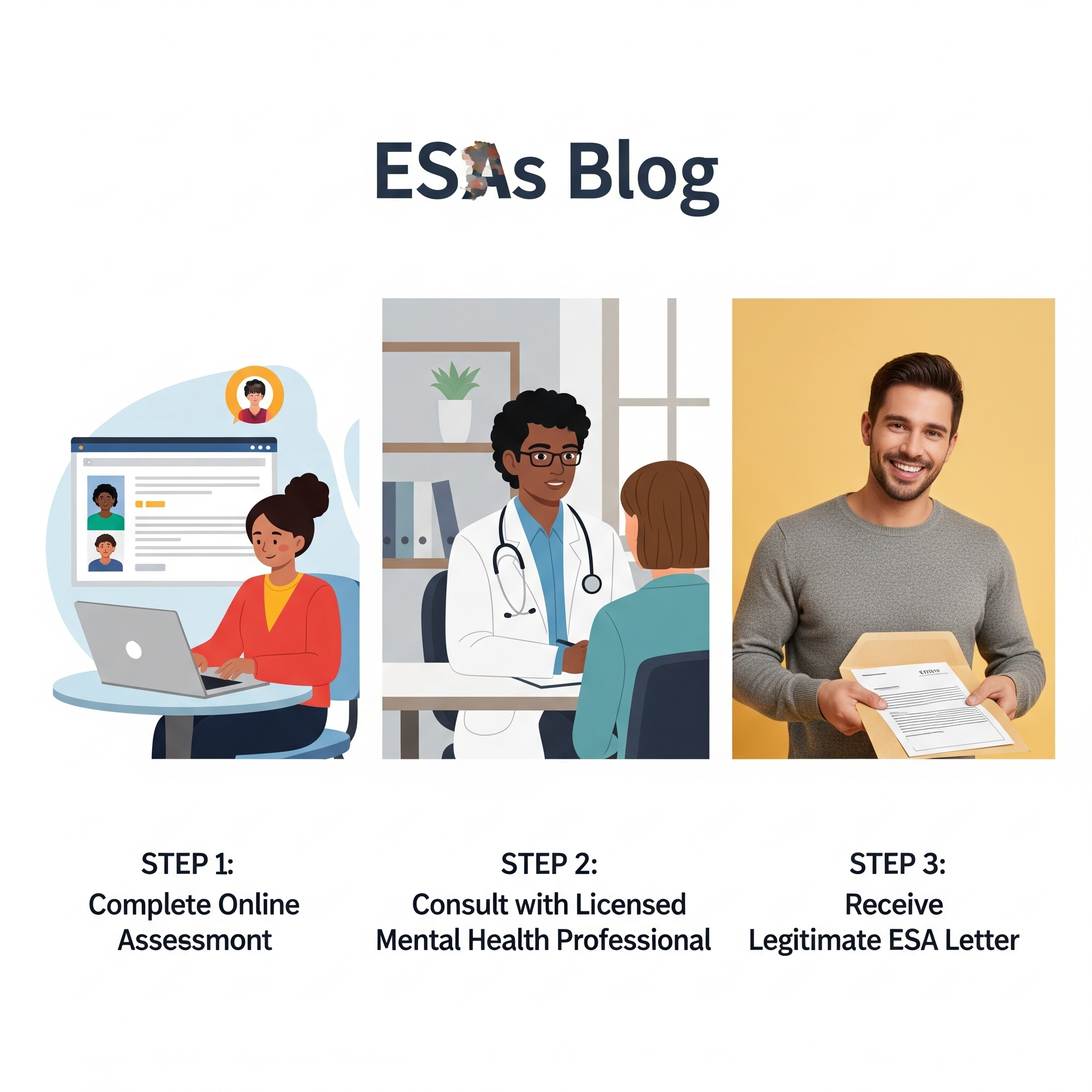For owners of Emotional Support Animals (ESAs) and Psychiatric Service Dogs (PSDs), proper gear isn’t just about aesthetics; it’s about functionality, safety, and clear identification. While an ESA’s gear primarily focuses on comfort and responsible pet ownership within housing, a PSD’s gear often plays a crucial role in public access and communication. Understanding the best leashes, vests, and tags can make a significant difference in your daily life with your assistance animal.
At CertifyESA, we empower individuals by connecting them with licensed mental health professionals for legitimate ESA and PSD letters, ensuring their right to reasonable accommodations. While we don’t provide gear directly, we understand its importance. This blog will guide you through the essential gear choices for both ESA and PSD owners, highlighting how each piece contributes to a harmonious and compliant partnership.
The Core Difference in Gear Needs: ESA vs. PSD
It’s vital to reiterate the distinction between ESAs and PSDs, as their legal roles dictate different gear requirements:
-
Emotional Support Animals (ESAs): Primarily recognized under the Fair Housing Act for housing accommodations. They do not require specialized training or public access gear. Their gear needs are akin to a well-behaved pet – a comfortable leash, collar, and perhaps an ID tag for safety. While some ESA owners choose to use vests, it’s not legally required and doesn’t grant public access rights beyond housing.
-
Psychiatric Service Dogs (PSDs): Recognized under the Americans with Disabilities Act (ADA) for public access. PSDs are individually trained to perform specific tasks directly related to a handler’s psychiatric disability. While the ADA doesn’t mandate specific gear (like vests or tags), having visible identification can prevent unnecessary questioning and educate the public (U.S. Department of Justice, 2015). Their gear focuses on control, comfort during task performance, and clear communication to the public that they are working.
Essential Gear for All Owners: The Basics
Regardless of whether your animal is an ESA or a PSD, some fundamental gear is essential for responsible ownership:
1. Collars and Harnesses
-
Flat Collar: The most common type, suitable for carrying ID tags. Ensure it’s snug enough not to slip off but loose enough for comfort (two fingers should fit underneath).
-
Martingale Collar: Offers more control than a flat collar without choking, as it tightens slightly if the dog pulls. Good for dogs who can slip out of flat collars.
-
Front-Clip Harness: Attaches the leash at the dog’s chest, redirecting their pulling motion back towards you. Excellent for preventing pulling and maintaining control without putting pressure on the dog’s neck.
-
Back-Clip Harness: Attaches the leash on the dog’s back. While less effective for pulling, it’s comfortable for dogs who don’t pull and is suitable for lighter control or for dogs performing tasks where chest pressure would interfere.
Recommendation: For daily walks and general control, a front-clip harness is often recommended for its gentle yet effective anti-pulling capabilities. Always ensure a proper fit to prevent chafing or discomfort.
2. Leashes
-
Standard 4-6 Foot Leash: The most versatile and recommended leash length for control and communication with your dog in various environments. Ideal for walks and training.
-
Hands-Free Leash: Can be worn around your waist, freeing up your hands. Beneficial for individuals with mobility issues or those who need to manage other items. Ensure your dog is well-trained on a hands-free leash to avoid being pulled off balance.
-
Long Line (15-30+ feet): Used for recall training or allowing more freedom in safe, open spaces. Not for everyday public use.
Avoid: Retractable leashes are generally discouraged for service animals (and often for pets in public) as they offer less control, can injure handlers or others, and teach a dog to pull.
Specialized Gear for Psychiatric Service Dogs (PSDs): Public Access & Identification
For PSDs, additional gear serves to identify them as working animals and assists in task performance and public access.
1. Service Dog Vests/Harnesses
While not legally required by the ADA, a vest or harness clearly identifying a dog as a “Service Dog” or “Service Animal” can significantly reduce questioning and improve public understanding.
- Types: Vests range from lightweight mesh to more robust padded harnesses.
- Visibility: Choose bright colors or reflective materials for visibility, especially in low light.
- Labeling: Ensure prominent patches or embroidery stating “Service Dog,” “Service Animal,” or “Psychiatric Service Dog.” Avoid terms like “Emotional Support Animal” on a PSD vest, as this can cause confusion and undermine its service animal status.
- Pockets: Some vests include zippered pockets, useful for carrying medication, emergency contact information, or small supplies.
- Handles: Sturdy handles on a vest can provide support or assist with mobility tasks if relevant to the handler’s disability (though less common for psychiatric tasks).
Benefit: A clear vest acts as a visual cue to the public that the dog is working and should not be distracted, asked to be petted, or interfered with.
2. Identification Tags
Beyond basic owner ID tags, specialized tags for PSDs further communicate their role.
- “Do Not Pet” / “Working Dog” Tags: These can be invaluable for deterring distractions from the public, helping the dog remain focused on their handler.
- QR Code Tags: Some advanced tags incorporate QR codes that, when scanned, link to relevant information (e.g., handler’s contact, basic service animal laws – not personal medical information).
- Legal ID Tags (Optional): Some states or organizations offer voluntary registration or ID cards, but these are not recognized or required by federal ADA law (U.S. Department of Justice, 2015). The most important “identification” for a service dog is its behavior and task performance.
3. Foot Protection (Paw Boots/Shoes)
While not always necessary, paw protection can be crucial in certain environments:
- Hot Pavement/Surfaces: Essential in summer to prevent burns on asphalt or concrete.
- Snow/Ice/Salt: Protects paws from extreme cold, ice melt chemicals, and sharp ice.
- Rough Terrain: Guards against cuts or abrasions on rocky or uneven surfaces.
- Allergens: Can help reduce exposure to environmental allergens if a dog has sensitive paws.
Consideration: Introduce paw boots slowly and positively, as many dogs take time to adjust to them.
4. Cooling/Warming Vests (Situational)
For dogs working in extreme temperatures, specialized vests can help regulate their body temperature.
- Cooling Vests: Activated by water, they wick away heat from the dog’s body.
- Warming Vests: Provide insulation for cold climates or for dogs with short coats.
What Not to Use for Identification
-
“ESA” Vests in Public (outside of housing): While you can put an “ESA” vest on your emotional support animal, understand that it does not grant public access rights (like into stores or restaurants) under the ADA. It might even cause confusion, as the public may not understand the distinction, or lead to confrontations. An ESA’s primary right is for housing under the FHA.
-
Fake Certificates/Registries: There are many online services that sell “ESA certifications” or “Service Dog registrations.” These are not recognized by the ADA or FHA and offer no legal protection (U.S. Department of Justice, 2015). The only legitimate way to establish an ESA is through a letter from a licensed mental health professional, and a PSD is identified by its task training.
The Role of CertifyESA in Your Journey
At CertifyESA, we are your trusted resource for obtaining legitimate ESA and PSD letters from licensed mental health professionals. We do not sell gear or “certify” animals; instead, we provide the crucial documentation that confirms your disability and the need for your assistance animal for reasonable accommodations.
-
For ESAs: A legitimate ESA letter is the only documentation needed for housing accommodations under the FHA. Your gear choices are for comfort and responsible pet ownership.
-
For PSDs: While the ADA does not require a PSD letter for public access, having one from a licensed mental health professional (like those in our network) can affirm your psychiatric disability and the necessity of your task-trained service dog. This letter can be beneficial for housing and to provide clarity if needed, even as the focus for public access remains on the dog’s training and behavior (U.S. Department of Transportation, 2020). The gear you choose for your PSD serves to communicate their working status and aid in their tasks.
By partnering with CertifyESA, you ensure that the foundation of your assistance animal partnership – the legitimate documentation – is solid, allowing you to then focus on equipping your companion appropriately and confidently.
Conclusion: Equipping for Confidence and Compliance
Choosing the right gear for your Emotional Support Animal or Psychiatric Service Dog is an important aspect of responsible ownership and effective partnership. For ESAs, basic, comfortable, and safe gear suffices for housing. For PSDs, gear like clearly labeled vests, “Do Not Pet” tags, and practical harnesses are invaluable tools for public access, clear communication, and ensuring your working dog can perform their tasks without distraction.
Remember, no amount of specialized gear can replace the legitimate documentation of an ESA letter from a licensed mental health professional or the rigorous task training of a PSD. At CertifyESA, we empower you to secure this essential foundation, so you can then confidently select the best gear to support your unique bond and navigate the world with your invaluable companion.
APA Formatted Citations:
U.S. Department of Justice. (2015, July 20). Frequently Asked Questions about Service Animals and the ADA. Retrieved from https://www.ada.gov/resources/service-animals-faqs/
U.S. Department of Transportation. (2020, December 2). Traveling by Air with Service Animals; Final Rule. Federal Register. Retrieved from https://www.transportation.gov/sites/dot.gov/files/2020-12/Service%20Animal%20Final%20Rule.pdf





